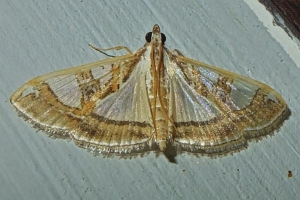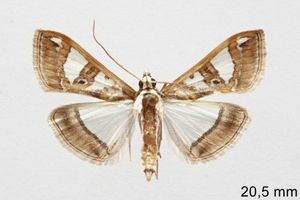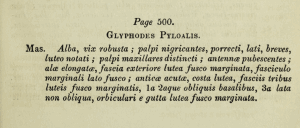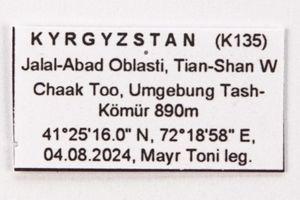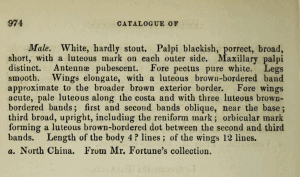

 +14Kontinente:ASNA
+14Kontinente:ASNA1. Lebendfotos
1.1. Falter
2. Diagnose
2.1. Männchen
2.2. Erstbeschreibung
3. Biologie
3.1. Nahrung der Raupe
- [Moraceae:] Morus alba (Weißer Maulbeerbaum, Weiße Maulbeere)
- [Moraceae:] Morus nigra (Schwarzer Maulbeerbaum, Schwarze Maulbeere)
- [Moraceae:] Morus indica (Indischer Maulbeerbaum)
- [Moraceae:] Morus sp. (Maulbeerbaum)
Khosravia & Jalali Sendia (2010) beginnen ihren Artikel: "Lesser mulberry pyralid, Glyphodes pyloalis Walker, is a monophagous pest of mulberry and has recently been reported in northern Iran." Ebenfalls aus dem Iran ist bei Piri et al. (2014) zu lesen: "Lesser mulberry pyralid, Glyphodes pyloalis Walker (Lepidoptera: Pyralidae), is a destructive pest of mulberry occurring in India, China, Korea, Japan, Malaysia, Pakistan, Uzbekistan, and Burma (Madyarov et al. 2006). This pest causes severe damages to mulberry trees also in northern Iran. Mulberry leaves are used for mass rearing of the silkworms (Bombyx mori L.) and so this pest can interfere with sericulture industry in Iran (Jaafari Khaljiri et al. 2006)." Moallem et al. (2017) stellen fest, dass die Larvalentwicklung nur oberhalb 16 °C und unterhalb 36 °C stattfindet.
In den diversen Arbeiten zur Kontrolle der Art wird in der Regel nicht zwischen den verschiedenen Maulbeerbaum-Arten unterschieden. Wenn doch eine Art benannt wird, dann meist Morus alba. Çeti̇n et al. (2020) führen größere wirtschaftliche Schäden in der Türkei sowohl an Morus alba als auch an M. nigra an.
(Autor: Erwin Rennwald)
4. Weitere Informationen
4.1. Synonyme
- Glyphodes sylpharis Butler, 1878
4.2. Faunistik
Als locus typicus wird in der Erstbeschreibung pauschal "North China" genannt. Basis für die Beschreibung war ein einzelnes Männchen "From Mr. Fortune's collection". Das Synonym Glyphodes sylpharis Butler, 1878 wurde aus Japan beschrieben. Dort angrenzend ist G. pyloalis auch aus der Region Primorje ganz im Südosten von Russland bekannt. Die Art ist in Ostasien, aber auch im Iran und mehreren afrikanischen Ländern verbreitet und gilt dort teilweise als Schädling an Maulbeerbäumen (siehe dazu auch "Nahrung der Raupe"). Die Art wird auch im Südteil der Ostküste der USA gefunden (vor allem Florida, im Norden bis Virginia, siehe: [mothphotographersgroup.msstate.edu])
Nachdem die Art in den Jahren zuvor auch als Schädling an Maulbeerbäumen in Georgien und Aserbaidschan wowie der Türkei aufgetreten war, war eine weitere Ausbreitung auch nach Europa zu erwarten. Poltavsky & Ilyina (2016) berichten über den ersten Fund eines Falters am Licht in Dagestan, konkret am 29. Juli 2015 bei Tagirkent-Kazmalyar im Deltabereich des Samur, also fast am Kaspischen Meer und ganz im Süden des Landes nahe der Grenze zu Aserbaidschan. Je nach Definition der Grenzziehung zwischen Asien und Europa gehört dieser Fundort zu Asien oder Europa. Poltavsky & Ilyina (2016) vermerken, dass es in Dagestan nur relativ wenige Maulbeerbäume und keine Seidenspinnerzucht gibt; insofern ist hier auch kaum mit größeren Schäden zu rechnen.
4.3. Typenmaterial
Das einzige Exemplar der Erstbeschreibung - und damit der Holotypus - befindet sich im BMNH in London.
(Autor: Erwin Rennwald)
4.4. Literatur
- Çeti̇n, G., Göksel, P.H., Özdemi̇r, M. & Y Boz (2020): A pest that could be posing a threat to mulberry production of Turkey: Glyphodes pyloalis (Walker, 1859) (Lepidoptera: Crambidae). Türkiye dut üretimini tehdit edebilecek bir zararlı: Glyphodes pyloalis (Walker, 1859) (Lepidoptera: Crambidae). — Bitki Koruma Bülteni / Plant Protection Bulletin, 60 (3): 39-45. [PDF auf dergipark.org.tr]
- Khosravia, R. & J. Jalali Sendia (2010): Biology and demography of Glyphodes pyloalis Walker (Lepidoptera: Pyralidae) on mulberry. — Journal of Asia-Pacific Entomology, 13 (4): 273–276. [Abstract auf sciencedirect.com]
- Moallem, Z., Karimi-Malati, A., Sahragard, A. & A. Zibaee (2017): Modeling Temperature-Dependent Development of Glyphodes pyloalis (Lepidoptera: Pyralidae). — Journal of Insect Science, 17(2), 37: 1-8. [http://doi.org/10.1093/jisesa/iex001] [PDF auf ncbi.nlm.nih.gov]
- Piri, F., Sahragard, A. & M. Ghadamyari (2014): Effects of Spinosad on Some Biochemical and Biological Parameters of Glyphodes pyloalis Walker (Lepidoptera: Pyralidae). — Plant Protection, Faculty of Agricultural Science, 50 (3): 135–144. [PDF auf agriculturejournals.cz]
- Полтавский, А.Н. & Е.В. Ильина (2016): Glyphodes pyloalis Walker, 1859 (Lepidoptera, Crambidae) - НОВЫЙ ВИД ТРОПИЧЕСКОЙ ОГНЁВКИ ДЛЯ ФАУНЫ ДАГЕСТАНА. — Российский Журнал Биологических Инвазий 4: 110-112. [Poltavsky, A.N. & E.V. Ilyina (2016): Glyphodes pyloalis Walker, 1859 (Lepidoptera, Crambidae) - a new species of Tropical snout-moth for the Fauna of Dagestan.] [PDF auf sevin.ru]
- Erstbeschreibung: Walker, F. (1859): Pyralides. — List of the Specimens of Lepidopterous Insects in the Collection of the British Museum, London 19: i-iv, 799-1036.













